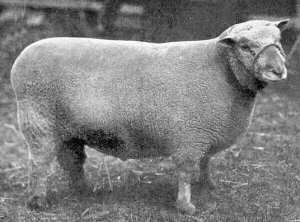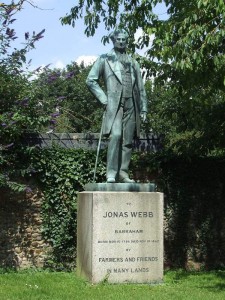If you pick up any historical publication on sheep you will find the Southdown discussed in detail.
Therefore one can’t start a history about the Southdown sheep breed in New Zealand without first delving further back into the breed’s history and perhaps from that determine why the early farm settlers of NZ would want to use this breed.
The Southdown originated in the United Kingdom and is the oldest of the terminal sire breeds, and, as the name would suggest, originated from the native sheep which roamed the South Downs in the South of England for many hundreds of years. Its homeland is the Sussex Down hills, particularly around Lewes in East Sussex and its pedigree is said to be ‘older than that of the peerage’.
Southdown numbers in Sussex in 1341 were estimated at around 110,000. Their wool was rated as only of slightly less quality and fineness than the Hereford sheep. The popularity of the Southdown in the UK peaked from around 1790 to the First World War. Flocks of 1000 or more were to be found on the large estates as well as smaller numbers on the small holdings of peasant farmers.
In 1813, the eastern South Downs carried some 200,000 Southdown ewes. Such large concentrations of sheep played a crucial role in maintaining soil fertility. The open downs were grazed during the day then the flocks were brought down to the lower arable lands to be penned in ‘folds’ for the night.
The chalky downland soils were well manured and trodden by the sheep. New crops such as field turnips, swedes and other forage crops were introduced. The folding system of animal husbandry reached its peak during the years from 1845 to around 1875.
With the gradual introduction of new crops such as field turnips, swedes, kohl rabi and other forage crops, the folding system took off, increasing in parallel with expanding human population. The system reached its zenith in the years from about 1845 to 1880.
However, as the use of artificial fertilizers gained ground, and the combine-drill, which sowed grain seeds and fertilizer together, this rendered close-folding by sheep unnecessary.
This meant the breed had to evolve, and as would become a trait throughout its history, the Southdown surrendered to these basic arable farming changes and became largely a grassland breed.
Developed by foresighted flockmasters into a fixed type in the eighteenth century, the Southdown breed has gone on to be of tremendous importance in New Zealand – not only as a producer of the very best fat lambs but also as a progenitor of many other sheep breeds and has been responsible for the development of many of the terminal sire breeds, including the Suffolk and the Hampshire Down and in France the Charollais.
Apart from being a specialist meat breed on its own, Southdowns have also been very important in contributing their meat qualities to other breeds through crossing and interbreeding to form new breeds.
Examples: South Dorset (Southdown x Dorset), South Dorset Down (Southdown x Dorset Down), South Suffolk (Southdown x Suffolk), South Hampshire (Southdown x Hampshire).
Their development into a premier British breed was carried out by John Ellman of Glynde, near Lewes, starting in 1780. Ellman began a far-reaching improvement of the breed by selecting the best examples for his breeding stock. He did not outcross to other breeds. He became very well-connected, won shows with ease and even sold two of his rams to Emperor Paul I of Russia for 300 guineas.
Jonas Webb of Babraham in Cambridgeshire acquired his flock of the then rare Southdowns from John Ellman and continued this work producing a rather larger animal which was subsequently used in the development of other Downs breeds. Webb bred them to produce a strain of larger size, earlier maturity and improved fleece quality. He exported Southdowns all over the world, to countries including France, Spain, Australia and New Zealand.


